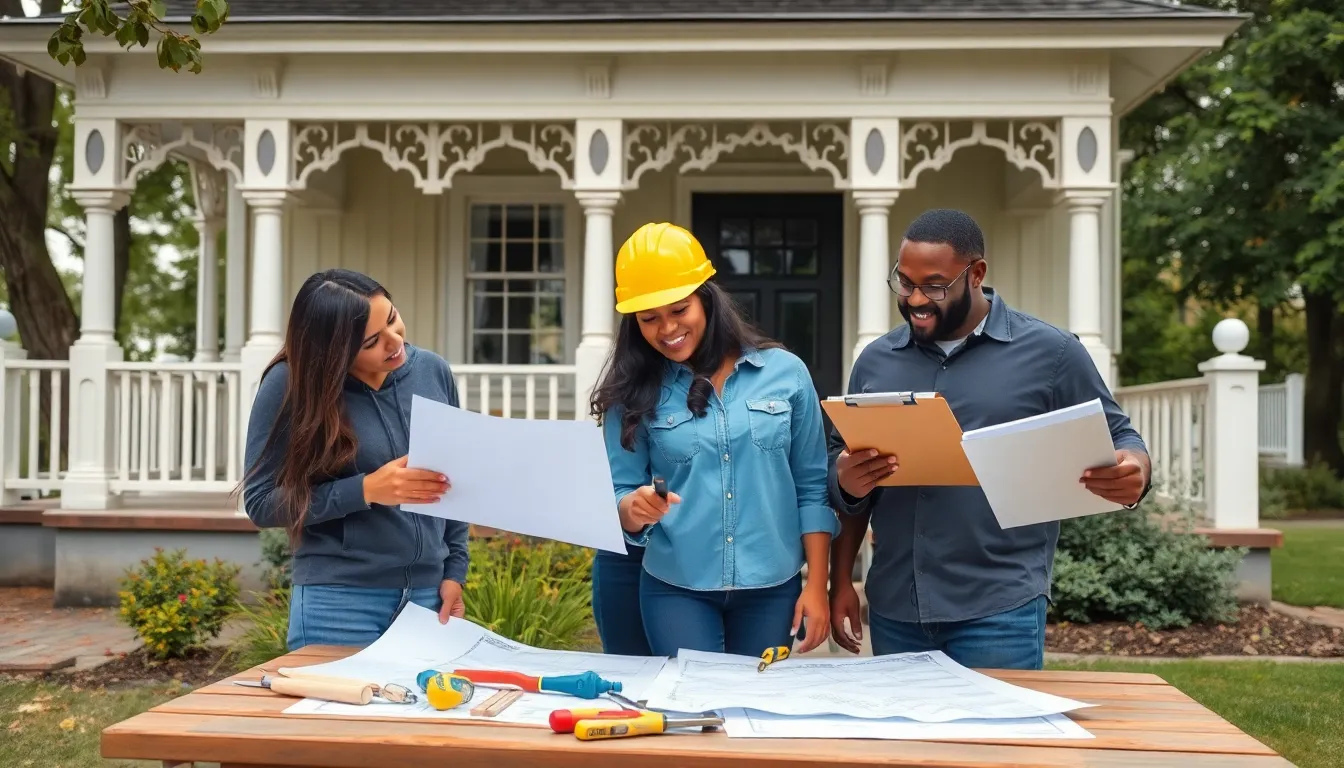Old homes have a charm that modern builds just can’t replicate. With their creaky floorboards and quirky layouts, these vintage treasures whisper stories of the past. But let’s face it—while nostalgia is nice, outdated plumbing and questionable wallpaper choices can make any homeowner cringe. Renovating an old home isn’t just about slapping on a fresh coat of paint; it’s a thrilling adventure filled with surprises, challenges, and perhaps a few unexpected encounters with the local rodent population.
Embracing the old while breathing new life into it can turn a fixer-upper into a dream home. Whether it’s preserving original features or adding modern amenities, the journey of renovation is as rewarding as it is chaotic. So grab your toolbelt and a sense of humor; it’s time to transform that charming relic into a stylish sanctuary that still pays homage to its storied past.
Table of Contents
ToggleThe Basics of Old Home Renovation
Renovating old homes presents unique opportunities and challenges. Understanding these elements fosters a successful transformation.
Understanding the Challenges
Old homes often come with hidden issues like outdated plumbing, electrical systems, and structural concerns. Homeowners face surprises, including warped floors or unexpected mold instances. Each renovation requires assessing these potential problems before starting. They prioritize finding reliable contractors who specialize in vintage properties. Patience plays a vital role during the renovation process since unexpected delays may arise. Emphasizing practicality alongside aesthetics ensures that the home becomes functional and visually appealing.
Assessing Historical Value
Determining a home’s historical value requires thorough research and expert input. Older homes may possess unique architectural elements that contribute to their significance. Investigating local histories, original blueprints, and previous renovations helps identify these features. Historic preservation societies and local archives provide valuable resources for insights. Engaging with architects familiar with restoration techniques enhances understanding. Assessing a property’s historical relevance guides renovation decisions that honor the past while modernizing spaces. Balancing preservation with innovation creates a harmonious renovation outcome that celebrates the home’s story.
Planning Your Old Home Renovation

Planning a renovation for an old home requires careful consideration. Determining key factors early sets the stage for a successful project.
Setting a Budget
Establishing a budget involves assessing the overall financial scope of the renovation. Prioritize essential repairs like plumbing updates and electrical rewiring, which are often necessary in vintage properties. Allocate funds for unexpected expenses, as hidden issues can arise. A specific percentage, about 10 to 20, should be reserved for contingencies to cover surprises. Include costs for permits, materials, and labor, ensuring every aspect is accounted for. Seeking quotes from contractors ensures a well-rounded understanding of potential expenses. Doing this step efficiently can lead to smoother transitions throughout the renovation process.
Creating a Timeline
Establishing a timeline helps keep the renovation on track. Break the project into phases, such as planning, permitting, and construction. Each phase should have specific start and end dates, with realistic time frames based on project complexity. Consult experts who specialize in old homes to gauge typical time requirements for renovations. Adjust timelines based on seasonal factors, as certain tasks may be weather-dependent. Regularly reviewing the schedule keeps everyone aligned and productive. This structured approach enhances clarity and maintains focus on completing the project successfully.
Essential Renovation Techniques
Renovating an old home involves employing specific techniques to maintain its charm while updating essential features. Featured below are key areas to focus on during the renovation process.
Restoring Original Features
Restoring original features enhances a home’s historical appeal. Many old homes reveal unique architectural details like moldings, fireplaces, and hardware that reflect their time period. Professionals often recommend careful restoration instead of complete replacement. Homeowners can utilize period-appropriate materials and finishes to retain authenticity. Engaging skilled craftsmen ensures that restoration aligns with historical accuracy. Exploring local resources can also help in sourcing original or reproduction elements. Preserving key aspects of design honors the home’s heritage.
Upgrading Modern Amenities
Upgrading modern amenities offers comfort and efficiency. Plumbing systems, electrical wiring, and insulation frequently require updates to meet current standards. Assessing the home’s structural integrity is essential when adding modern conveniences. Heavily retrofitting outdated bathrooms or kitchens transforms functionality while respecting original designs. Incorporating energy-efficient appliances reduces utility costs and enhances comfort. Notably, smart home technologies can integrate seamlessly without compromising character. Prioritizing modern accessibility features makes the home welcoming for all residents.
Hiring Professionals for Renovation
Renovating an old home often requires professional expertise. Hiring knowledgeable contractors can streamline the renovation process, ensuring quality work and adherence to preservation standards.
Finding the Right Contractor
Identifying a qualified contractor is essential. Homeowners should seek professionals experienced with vintage homes. Reading reviews and checking references provides valuable insights into a contractor’s reliability. Attending local home shows can also connect homeowners with potential contractors. Obtaining multiple estimates allows for comparison, ensuring fair pricing. Clear communication with chosen contractors regarding vision and expectations leads to a smoother renovation. Trust your instincts; a good relationship enhances collaboration and results in a successful transformation.
Understanding Permits and Regulations
Navigating permits and regulations is crucial during renovations. Local building codes dictate necessary permits for major changes. Homeowners must research requirements in their area to avoid complications. Consulting with contractors often clarifies what permits are needed and how to obtain them. Failing to secure proper permits can result in costly fines and project delays. Additionally, historic preservation rules may apply, especially in designated districts. Understanding these regulations protects the home’s value and ensures compliance throughout the renovation journey.
Renovating an old home is more than just a project; it’s a journey that connects the past with the present. Homeowners can breathe new life into these vintage treasures while preserving their unique character. By embracing both the challenges and rewards of renovation, they can create a harmonious blend of history and modern living.
With careful planning and the right expertise, transforming a fixer-upper into a stylish sanctuary is achievable. The right balance of restoration and modernization ensures that these homes continue to tell their stories for generations to come. As each renovation unfolds, it becomes a celebration of craftsmanship and a testament to enduring beauty.


